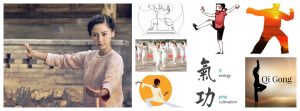
Qigong practice typically involves moving meditation, coordinating slow flowing movement, deep rhythmic breathing, and calm meditative state of mind. Qigong is now practiced throughout China and worldwide for recreation, exercise and relaxation, preventive medicine and self-healing, alternative medicine, meditation and self-cultivation, and training for martial arts.
Over the centuries, a diverse spectrum of qigong forms developed in different segments of Chinese society. Traditionally, qigong training has been esoteric and secretive, with knowledge passed from adept master to student in lineages that maintain their own unique interpretations and methods. Qigong practices were brought to the public beginning in the 1950s, when the Communist Party institutionalized and began research into traditional Chinese medicine. Although the practice of qigong was prohibited during the Cultural Revolution of the 1960s, it was once again allowed after 1976. On account of the political climate at the time, the emphasis of qigong practices shifted away from traditional philosophy and cultivation, and increasingly focused health benefits, medicine and martial arts applications, and a scientific perspective. Since a 1999 crackdown, practice of qigong in China has been restricted. Over the same period, interest in qigong has spread, with millions of practitioners worldwide.
Research concerning qigong has been conducted for a wide range of medical conditions, including hypertension, pain, and cancer treatment.
